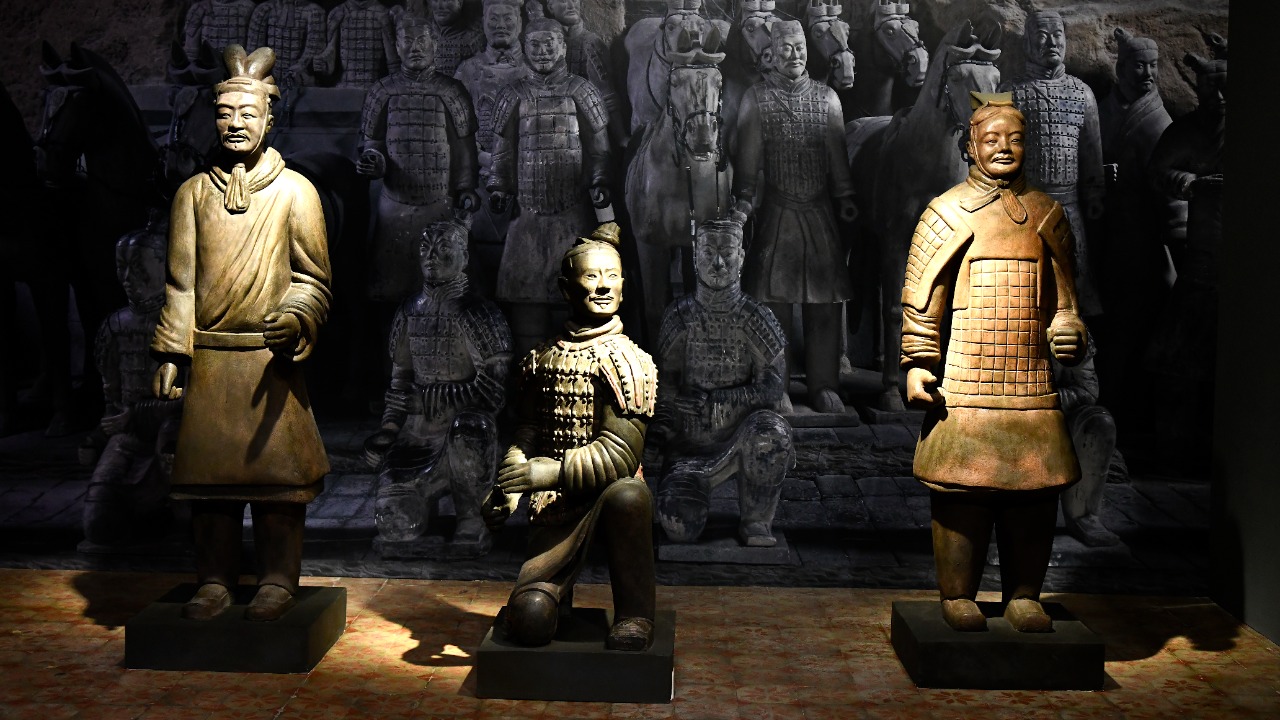
The tomb of China’s first emperor, Qin Shi Huang, remains an enigma, shrouded in mystery and danger. Despite the advancements in archaeological technology, the tomb, located near modern-day Xi’an, remains unopened due to fears of deadly booby traps. These traps, as described in ancient texts, were designed to protect the emperor’s afterlife domain. The tomb, completed over 2,200 years ago, continues to captivate and intimidate archaeologists who have only dared to excavate the surrounding pits, revealing the famous Terracotta Army.
Qin Shi Huang: Unifier and Tyrant
Qin Shi Huang’s rise to power is a tale of ambition and ruthlessness. As the king of the Qin state, he conquered rival kingdoms, unifying China and declaring himself the first emperor in 221 BCE. His obsession with immortality led him to commission the creation of elixirs and a massive tomb project around 246 BCE, designed to replicate his empire in the afterlife.
However, his reign was marked by brutal policies. He standardized weights, measures, and script across his empire, creating a unified system of governance. Yet, he also suppressed Confucianism, leading to widespread book burnings and executions, cementing his legacy as a tyrant.
The Mausoleum’s Grand Design
The scale of Qin Shi Huang’s tomb is staggering. Covering 56 square kilometers, the mausoleum is said to feature an inner chamber with a map of the empire under a celestial dome, as recorded by historian Sima Qian. The construction of this grand mausoleum involved 700,000 laborers over 38 years, with the emperor’s death in 210 BCE accelerating its rushed completion.
Perhaps the most intriguing aspect of the tomb’s design is the integration of booby traps into the structure. These traps, designed to deter grave robbers, have become a significant deterrent for modern archaeologists, adding to the tomb’s enduring mystery.
Discoveries of the Terracotta Army
In 1974, farmers accidentally unearthed Pit 1, revealing over 8,000 life-sized clay soldiers, horses, and chariots facing east to guard the emperor. Subsequent excavations uncovered Pits 2 and 3, containing additional figures like archers and officials, totaling around 10,000 statues, all uniquely crafted.
The Terracotta Army serves as eternal protectors for the emperor, equipped with weapons like real crossbows that remain functional after restoration efforts. This discovery underscores the lengths Qin Shi Huang went to ensure his protection in the afterlife.
Ancient Warnings of Perils Inside
Sima Qian’s “Records of the Grand Historian” from the 1st century BCE warns of automated crossbows triggered by intruders and models of palaces filled with treasures within the tomb. The text also describes simulated rivers and seas made of mercury, intended to mimic the Yangtze and Yellow Rivers. Modern surveys have reportedly detected mercury levels 100 times above safe limits, leading to fears of toxic hazards from mercury vapors that could endanger excavators.
Historical Attempts and Failures
There have been several attempts to loot the tomb throughout history. Xiang Yu’s forces in 206 BCE burned the outer buildings but avoided the sealed core due to fears of traps. Later, during the Han dynasty, partial explorations uncovered some artifacts but also triggered mechanisms causing collapses.
These historical failures contribute to the ongoing reluctance among archaeologists to risk opening the tomb, despite the potential historical significance of its contents.
Modern Technology vs. Ancient Threats
Modern technology has provided non-invasive methods to explore the tomb. Techniques like ground-penetrating radar and muon tomography have been used since the 2000s to map the tomb without entry, revealing a large pyramid-shaped mound. However, the Chinese government prioritizes preservation over excavation, with experts like Yuan Zhongyi advocating caution in the 1990s.
Despite these advancements, the potential for booby trap activations that could destroy invaluable artifacts upon breach remains a significant concern, further complicating the decision to open the tomb.
Implications for Archaeology and Legacy
The tomb of Qin Shi Huang raises ethical debates on balancing discovery with conservation. The site has been granted World Heritage status by UNESCO since 1987, emphasizing its historical and cultural significance. Yet, the potential dangers within the tomb pose a significant challenge to archaeologists.
Historical accounts suggest that the tomb may contain the emperor’s sarcophagus and concubines reportedly buried alive. The discovery of these artifacts could provide invaluable insights into the life and reign of China’s first emperor. However, the risks associated with opening the tomb serve as a reminder of the need for caution when dealing with booby-trapped sites in global archaeology.
More from MorningOverview